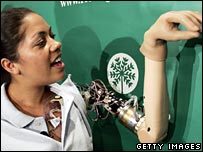
|
| Claudia Mitchell became the first woman to receive a bionic arm |
By rerouting the remaining nerves from their lost limbs to their chests, the patients said they could feel their missing arms and hands in their chests.
When heat or pressure was applied to the chest, the patients said they felt as if their hand was being touched.
The results appeared in the Proceedings of the National Academy of Sciences.
Dr Todd Kuiken, who led the research, said it could pave the way to providing amputees with the ability to feel what he touches with a prosthetic hand as if it were his own hand.
The patients involved are believed to be a man and a woman who were the first recipients of "bionic" arms which they could control by thought alone.
Claudia Mitchell, a former US marine, was given the new arm last year after losing hers at the shoulder in a motorbike accident. Double amputee Jesse Sullivan received his in 2001.
Using these arms, the two are for instance able to fold clothes, eat bananas and do the washing up.
Exciting advance
Electrodes attached to a harness on the shoulder of each patient were able to detect messages from the brain to the chest muscle, and forward them to the arm.
This next step opens the door to a sense of touch, the lack of which is currently seen as a major limitation on the efficacy of prosthetic limbs.
The two involved were able to differentiate between sensation in their actual chest, and one which they attributed to their hand.
In some cases they were able to pinpoint exactly where on the hand the sensation was being felt.
Dr Sellaiah Sooriakumaran, a consultant in rehabilitation at Queen Mary's, said this was an important next step.
"Making the new arm in the first place was a major breakthrough, and this is a very exciting advance on that."
"Giving prosthetic arms a sensory ability would dramatically improve their functionality and their acceptance by the patient."



Reader Comments
to our Newsletter